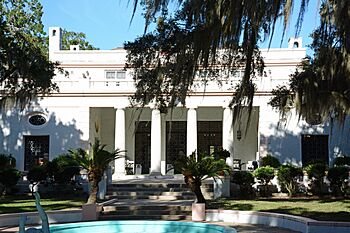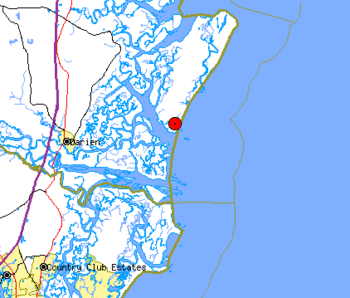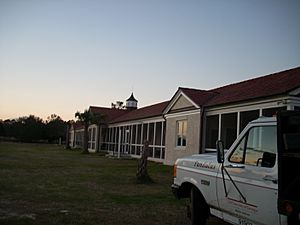Sapelo Island facts for kids

R. J. Reynolds mansion
|
|

Sapelo Island map
|
|
| Geography | |
|---|---|
| Location | McIntosh County, Georgia |
| Coordinates | 31°28′39″N 81°14′30″W / 31.47750°N 81.24167°W |
| Administration | |
|
United States
|
|
Sapelo Island is a special barrier island in McIntosh County, Georgia. It is protected by the state. You can only reach the island by boat. The main ferry ride from the Sapelo Island Visitors Center takes about 20 minutes.
Sapelo Island is home to Hog Hammock. This is the last known Gullah community. The Gullah people are descendants of West Africans. They were brought to the island long ago. To visit Sapelo Island, you need a special permit. This permit is given by state tourism groups.
Most of the island, about 97 percent, belongs to the state of Georgia. The Georgia Department of Natural Resources manages it. The rest of the island is privately owned. The western side of Sapelo is the Sapelo Island National Estuarine Research Reserve. This area helps protect the natural environment. The University of Georgia Marine Institute is also on the island. It focuses on research and teaching. The Reynolds Mansion, a Georgia State Park, is on the south end.
Contents
Hog Hammock: A Unique Community
The community of Hog Hammock is also called Hogg Hummock. It has homes, a general store, and a public library. There are also small businesses, including places to rent for vacations. Two churches are active in Hog Hammock. St. Luke Baptist Church started in 1885. First African Baptist Church began in 1866. An older building for the First African Baptist Church is used for special events. It was built in 1900.
Many people living in Hog Hammock are African Americans. They are known as Gullah-Geechees. These are descendants of enslaved West African people. They were brought to the island in the 1700s and 1800s. They worked on large farms called plantations. About 47 Gullah-Geechee residents live there full-time. They bring most of their supplies from the mainland. Or they buy them at the small island store. Children from Hog Hammock take the ferry to the mainland for school. The island school closed in 1978.
Protecting Hog Hammock's Heritage
Hog Hammock is also home to the Sapelo Island Cultural and Revitalization Society, Inc. (SICARS). This group works to protect the Hogg Hummock Community. SICARS was started in 1993. It was founded by residents and their descendants. They wanted to help their community's future. They also wanted to teach visitors about the island's history. They want people to know Sapelo has been an African community for over 200 years. SICARS has over 600 members. They host a Cultural Day festival every October.
The entire Hog Hammock community is about 427 acres (173 ha). It was added to the National Register of Historic Places in 1996. This means it is a special historic area.
Challenges for the Community
In the 1990s, people from the mainland started buying land in Hog Hammock. They built vacation homes. In 2012, property taxes for Hog Hammock residents increased a lot. This happened even though there was no school on the island. The state also manages water, trash, and the ferry. There are no emergency services on the island. Residents and state staff volunteer to help. Some property owners saw their yearly tax bill jump from $600 to $2,100.
In 2013, a legal battle began over these tax increases. Some residents worried they would lose their family land. This land had been owned for many generations. The county did not maintain the main roads on the island. They had problems with flooding. A solution was agreed upon. The county would pay for new equipment for a volunteer fire station. They would also fix an old building for a community center.
In 2023, McIntosh County faced new legal issues with Hog Hammock. They changed a rule about building sizes. The historic area used to allow homes up to 1,400 square feet. The new rule allowed homes up to 3,200 square feet. This change came after a non-resident complained. He wanted to build a larger vacation home. This new rule went against the county's own plan. That plan said it would protect Hog Hammock's historic nature.
Community members faced challenges in sharing their views. They were not allowed to bring recording devices to a public meeting. The meeting was also set with very little notice. It was held after the last ferry left the island. This made it hard for many residents to attend.
Many people spoke against the new rule. State officials worried about the water system. Residents worried about losing the island's historic feel. They also worried about higher taxes. Scientists said larger homes could increase flooding. Religious leaders said Hog Hammock was important for faith. They felt large vacation homes would make it harder for current homeowners. The county planning department still moved the rule forward. They said the commissioners could send it back to be fixed later. Lawyers present said the meeting process was "very unusual."
At later meetings, many people expressed strong concerns. Some county officials said they wanted to keep residents happy. They also wanted progress in the community. But some accused officials of ignoring their own rules. They felt officials favored new developers over residents. The County Manager, Patrick Zoucks, said the state's land ownership caused money problems for the county. This was shared on social media and in newspapers.
After many complaints, recording devices were allowed at the last meeting. The commission voted 3-2 to pass the new rule. The Chairman and two commissioners voted for it. Two commissioners voted against it. One of them, Roger Lotson, represented Sapelo Island. He had seen why larger homes would not work. After the vote, the Chairman made comments that upset the community. He suggested it was the community's fault for selling land. Many complaints and legal challenges are still ongoing.
History of Sapelo Island
Sapelo Island might be where the first European settlement in the U.S. was. It was called San Miguel de Gualdape. This settlement lasted from 1526 to 1527. If this is true, it would also be the first place in the U.S. where a Catholic mass was held.
The name Sapelo comes from an Indian word. The Spanish called it Zapala. In the 1600s, the island was part of a Spanish mission area. After 1680, several missions moved to the island. One was called Santa Catalina de Guale.
In the early 1800s, Thomas Spalding bought the island. He was a future senator. He turned it into a large farm called a plantation. He sold oak wood for ships. He also used irrigation to grow crops. He grew Sea Island Cotton, corn, and sugar cane. Spalding brought 400 enslaved people to the island. They came from West Africa and the West Indies. They worked on the plantation. They also built what became the Spalding Mansion.
One of the enslaved people was Bilali Muhammad. He was a Muslim scholar from West Africa. He wrote a 13-page document about Islamic law on the island. This might be the first Islamic law text written in the United States.
In 1820, a brick lighthouse was built. It was dark for over 90 years. But it was fixed and lit again in 1998.
Spalding did not want slavery to end. He died in 1851. After slavery ended, the formerly enslaved people made their own settlements. Hog Hammock is the last one left. About 70 landowners live there. During the Civil War, the Spalding home was badly damaged.
In the early 1900s, Howard E. Coffin bought most of the island. He was the founder of the Hudson Motor Car Company. He paid $150,000 in 1912. He built many shell-covered roads. He also built bridges over creeks. He grew crops and raised cattle. The Coffins also fixed and made the Spalding house bigger. It became a beautiful island home. Former presidents Calvin Coolidge and Herbert Hoover visited. So did aviator Charles Lindbergh.
Richard Joshua Reynolds Jr. bought Sapelo from Coffin in 1934. He was from the R.J. Reynolds Tobacco Company. He continued to try new farming methods. Reynolds and his family lived on the island part-time for 30 years. He moved the African-American residents to Hog Hammock. Many worked as servants in his home. It was later called the Reynolds Mansion.
Ecology and Research on Sapelo
Wildlife on the Island
In 1923, Howard Coffin brought chachalacas to Sapelo. These are chicken-like birds from Mexico. He wanted more game birds for hunting. These birds now live on the island. There are about 30 to 40 of them. They have also spread to nearby islands.
Important Environmental Research
R.J. Reynolds Jr. started the Sapelo Island Research Foundation in 1949. He also helped fund the work of Eugene Odum. Odum's 1958 paper was called The Ecology of a Salt Marsh. It became very famous. Odum's paper showed how delicate nature's balance is in wetlands.
The Reynolds' foundation also helped fund the University of Georgia's research. Reynolds' widow, Annemarie Reynolds, sold Sapelo to Georgia. She sold it for $1 million. This was much less than it was worth. This happened in two sales in 1969 and 1976. The last sale created the Sapelo Island National Estuarine Research Reserve. This is a partnership between Georgia and the National Oceanic and Atmospheric Administration. Thanks to the Reynolds family, Sapelo is now open to the public. You need an appointment to visit.
How Sapelo Island Formed
Sapelo Island is in the Georgia Bight. This is a coastline with two high and low tides each day. The difference between high and low tides is about 7 feet. Sapelo Island is a barrier island shaped by these tides. Over millions of years, sea levels changed. This created the island's shape. The land under Sapelo Island is very old. It can be seen along Blackbeard Creek. The current island formed as sea levels rose after the last ice age.
Impact of Hurricane Irma
In 2017, Hurricane Irma caused a storm surge. This surge broke through the southern end of Blackbeard Island. It created a small new island. This new island is between Sapelo Island and Blackbeard Island.
Climate
| Climate data for Sapelo Island (1991–2020 normals, extremes 1957–present) | |||||||||||||
|---|---|---|---|---|---|---|---|---|---|---|---|---|---|
| Month | Jan | Feb | Mar | Apr | May | Jun | Jul | Aug | Sep | Oct | Nov | Dec | Year |
| Record high °F (°C) | 83 (28) |
86 (30) |
89 (32) |
95 (35) |
99 (37) |
101 (38) |
105 (41) |
102 (39) |
98 (37) |
94 (34) |
89 (32) |
84 (29) |
105 (41) |
| Mean daily maximum °F (°C) | 62.0 (16.7) |
64.4 (18.0) |
70.2 (21.2) |
76.5 (24.7) |
83.2 (28.4) |
88.5 (31.4) |
91.3 (32.9) |
90.0 (32.2) |
86.0 (30.0) |
79.1 (26.2) |
70.8 (21.6) |
64.4 (18.0) |
77.2 (25.1) |
| Daily mean °F (°C) | 52.3 (11.3) |
54.8 (12.7) |
60.5 (15.8) |
67.1 (19.5) |
74.8 (23.8) |
80.3 (26.8) |
83.0 (28.3) |
82.1 (27.8) |
78.6 (25.9) |
70.4 (21.3) |
61.5 (16.4) |
55.1 (12.8) |
68.4 (20.2) |
| Mean daily minimum °F (°C) | 42.6 (5.9) |
45.2 (7.3) |
50.9 (10.5) |
57.8 (14.3) |
66.3 (19.1) |
72.2 (22.3) |
74.8 (23.8) |
74.3 (23.5) |
71.2 (21.8) |
61.8 (16.6) |
52.1 (11.2) |
45.9 (7.7) |
59.6 (15.3) |
| Record low °F (°C) | 3 (−16) |
10 (−12) |
20 (−7) |
32 (0) |
41 (5) |
51 (11) |
59 (15) |
58 (14) |
48 (9) |
34 (1) |
25 (−4) |
9 (−13) |
3 (−16) |
| Average precipitation inches (mm) | 3.62 (92) |
3.09 (78) |
3.27 (83) |
3.54 (90) |
2.90 (74) |
6.61 (168) |
4.37 (111) |
6.66 (169) |
5.87 (149) |
4.68 (119) |
2.32 (59) |
3.02 (77) |
49.95 (1,269) |
| Average precipitation days (≥ 0.01 in) | 8.5 | 8.0 | 7.3 | 6.5 | 6.7 | 10.4 | 9.6 | 11.9 | 10.8 | 7.3 | 6.2 | 8.2 | 101.4 |
| Source: NOAA | |||||||||||||
Visiting Sapelo Island
The Georgia Department of Natural Resources (DNR) offers tours. You can book these through the Sapelo Island Visitors Center. Many island residents also offer private tours. These can be made to fit what you want to see. A state campground is also available. It is for groups of 15 to 25 people. It is on Cabretta Island, next to Sapelo Island.
Sapelo in Books and Media
- Cornelia Walker Bailey, a Sapelo resident, wrote a book. It's called God, Dr. Buzzard and the Bolito Man. It tells about growing up on Sapelo.
- Patrick Reynolds and Tom Shachtman wrote The Gilded Leaf. It talks about R. J. Reynolds Jr. when he owned Sapelo.
- Author Tom Poland wrote a novel. It is titled Forbidden Island... An Island Called Sapelo.
- Singer Larry Jon Wilson has a song called "Sapelo." It is about the island.
- Michele Nicole Johnson, an island resident, published a photo book. It is called Sapelo Island's Hog Hammock.
- Author T.C. Boyle set his 1990 novel East Is East on a fictional Georgia island. It is much like Sapelo Island.
- An episode of the show Dirty Jobs featured termite research. This was at the University of Georgia Marine Institute on Sapelo Island.
- The Sapelo Island National Estuarine Research Reserve has a podcast. It is called ‘Sapelo NERRds’. It talks about research on the island.
- An episode of ESPN's Outside the Lines was filmed on Sapelo Island. It told the story of Allen Bailey's childhood. It also covered the community's tax issues.
- The podcast Uncivil focused on the Gullah people's struggle. They work to keep their land and culture.
- PBS America Reframed has an episode about Sapelo. It includes interviews with Cornelia Walker Bailey and her family.
See also
 In Spanish: Isla Sapelo para niños
In Spanish: Isla Sapelo para niños





